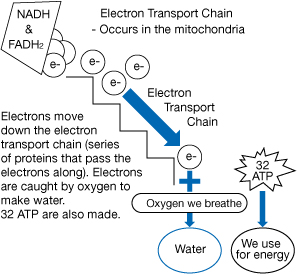Module 5 Intro
1. Module 5 Intro
1.30. Page 2
Module 5—Photosynthesis and Cellular Respiration
 Explore
Explore
 Read
Read
Krebs cycle: a metabolic pathway consisting of a series of reactions that break down the end products of glycolysis, producing carbon dioxide and generating a large amount of ATP; also know as the citric acid cycle; named after the 1953 Nobel Prize winning scientist who made the discovery
As you explored in Lesson 5, glycolysis is the first step in cellular respiration. Glycolysis is anaerobic, but cellular respiration can continue aerobically. Under oxygenated conditions, cellular respiration moves from the cytoplasm of the cell to the matrix of the mitochondria. The products of glycolysis—pyruvate and NADH—move into the matrix where they become a part of the Krebs cycle.
Aerobic respiration can be summarized by this familiar statement:
![]()
You will be exploring what happens inside the mitochondria to produce ATP, CO2(g) and H2O(l).
Before you continue with this lesson, it will be useful to read “Inside the Mitochondria: Krebs Cycle Preparation” and “The Krebs Cycle” on pages 187 and 188 of the textbook.
 Self-Check
Self-Check
SC 1. Complete this Self-Check activity.
 Read
Read
First, have a look at the simplified steps of aerobic respiration involving one molecule of glucose.
- Glycolysis:
- The first step breaks down glucose into pyruvate.

-
acetyl CoA: an oxidized form of glucoseIn the intermediate step, pyruvate is converted to acetyl CoA.
- Reduced NADH is produced as well as CO2(g).
NADH: a high-energy electron carrier
It acts as an electron donor to the electron transport system involved in the production of ATP.
FADH2: an important coenzyme produced during Krebs cycle
It acts as an electron donor to the electron transport system involved in the production of ATP.
- Krebs Cycle:
- acetyl CoA provides electrons for the electron transport chain.
-
acetyl CoA is oxidized to produce reduced NADH and FADH2.
-
acetyl CoA is oxidized to produce reduced NADH and FADH2.
- CO2(g) is produced.
- ATP is produced.

- Electron transport chain:
- Uses the electrons from NADH and FADH2 to make a lot of ATP
- The oxidation of NADH and FADH2 create a proton gradient that powers ATP synthase (chemiosmosis is similar to photosynthesis).

- The oxidation of NADH and FADH2 create a proton gradient that powers ATP synthase (chemiosmosis is similar to photosynthesis).
 Self-Check
Self-Check
SC 2. What compound derived from glucose actually enters the Krebs cycle?
SC 3. The carbon atoms derived from glucose are fully oxidized in the Krebs cycle. What becomes reduced during the Krebs cycle? (Remember: LEO the lion goes GER)
 Self-Check Answers
Self-Check Answers
SC 2. Acetyl CoA enters the Krebs cycle.
SC 3. NAD+ is reduced to NADH, and FAD is reduced to FADH2.
 Read
Read
How much energy does one glucose molecule provide when oxygen is the final electron acceptor?
ATP Totals for Aerobic Respiration
Glycolysis 2 ATP
Krebs Cycle 2 ATP
Electron Transport Chain 32 ATP
36 ATP from 1 glucose
You have determined that the electron transport chain creates most of the energy for cellular respiration. So, what is the purpose of the Krebs cycle?
 Watch and Listen
Watch and Listen
 Self-Check
Self-Check
SC 4. What is the purpose of the Krebs cycle?
SC 5. How does the word catabolism apply to the Krebs cycle?
 Self-Check Answers
Self-Check Answers
SC 4. The purpose of the Krebs cycle is to fully oxidize glucose, provide electrons for the electron transport chain, and create some usable energy for the cell.
SC 5. Catabolism means to break down molecules into smaller components and release energy. The Krebs cycle breaks down glucose through oxidation and ATP is synthesized.